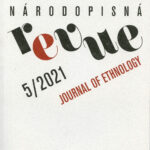Small Technical Heritage Objects in the Cultural Landscape: Research Possibilities and Conservation Challenges (Přemysl Mácha – Radek Bryol – Lenka Tlapáková – Radim Červenka – Vojtěch Bajer)
The Image of Staged Folk Culture: From the Presentation of Traditions to a Staged Genre (Martina Pavlicová)
Ethnological Research into Socialism in Post-Socialist (Czecho)Slovakia (Zuzana Beňušková)
Paths and Possibilities for Experiments in the Field of Traditional Technologies (in the Czech Republic) (Václav Michalička)
For all content click the button CONTENTS.
Small Technical Heritage Objects in the Cultural Landscape: Research Possibilities and Conservation Challenges
Small technical heritage structures in the cultural landscape present special challenges for their research and conservation. They are usually located on private land, many have disappeared entirely or have been refitted for a different purpose, and archival records are sparse or not available at all. The article describes experiences with the research and conservation of these structures in the Rožnov area in eastern Czechia. It outlines available methods, critically reflects on their application, and suggests ways for overcoming limitations associated with research of these structures. The article argues for the creation of a robust interdisciplinary research team including historians, anthropologists, GIS specialists, archaeologists, foresters, and geologists, to name a few. Also, it calls for the critical and complex use of archival materials, ethnographic interviews, and GIS in mutual interconnection. The conservation of small technical heritage objects is contingent on what we can find out about them through research as well as on their character, location, state of preservation, and on attitudes towards them held by owners, local inhabitants, and municipal authorities. A strong role can be played by private enthusiasts, local NGOs, and public officials as partners in the repair, renovation, and promotion of these structures. Open-air museums can contribute with expert supervision and methodical leadership to prevent amateur renovations from ruining the structures’ heritage value.
The Image of Staged Folk Culture: From the Presentation of Traditions to a Staged Genre
The study deals with the presentation of folk culture expressions on stage and tries to answer the questions that arise in this context. They relate both to the genesis of the presentation of folk traditions and to the subsequent developments that formed demonstrations of folk culture into a staged genre with artistic ambitions. Based on examples of selected expressions of folk culture in the Czech environment − especially expressions of folklore, which, alongside customary traditions, were always the backbone of staged presentations − the study shows how the demonstration of folk culture expressions was approached, how the performances were accepted by audiences, and which functions (ideological, artistic, and entertainment) were attributed to them. Another important question is what image of folk culture was created on the stage and how this image could have influenced the “living” terrain of the countryside and the very tendencies to protect the values of folk culture, which began to pick up strength in Czech society at the end of the nineteenth century.
Ethnological Research into Socialism in Post-Socialist (Czecho)Slovakia
The text presents an analytical overview of the results of ethnological research on the era of socialism conducted in Slovakia after 1989. It mainly describes the projects within which this research was carried out and the applied methodological approaches. It classifies the research results by thematic area and includes references to relevant academic publications. The text also mentions the academic discourse that resulted in several studies and themes. For the sake of comprehensiveness, basic projects, considerable museum activities, and audio-visual outcomes are mentioned, which provide knowledge about everyday life in socialism.
Paths and Possibilities for Experiments in the Field of Traditional Technologies (in the Czech Republic)
This study deals with experiments in the field of traditional production technologies. It focusses on experiments that can be used for ethnological interpretations. Attention is paid to both scientific experiments and results achieved by amateur experimenters. The theoretical introduction, defining the historical continuity and basic principles of empirical knowledge of traditional technologies based on experiments, is followed by a review text focussed on the form of contemporary experiments and reconstructions of historical technologies and techniques. An important part of the study presents examples of successful and significant experiments carried out in the Czech Republic. The experimental reconstruction of the technology used for the production of ash filtrates, which disappeared in the second half of the nineteenth century, is mentioned as an illustrative example. In the conclusion, the author points out the benefits and pitfalls associated with experiments in the field of traditional technologies.



